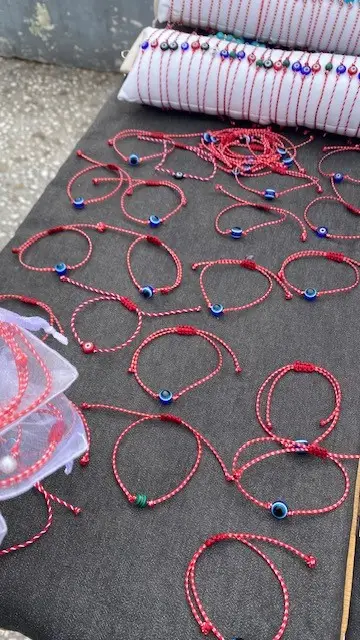Whilst wandering around Thisseio or Monastiraki in Athens, especially in the flea market, you can see a lot of red and white bracelets (martaki) adorned with pearls, the evil eye, a small olive tree, or a little cross. Just in front of the Ancient Agora, I found a lovely lady who was selling bracelets, including ones like these. As my Greek speaking is always in need of a little practice, I asked her about the red and white bracelets.
What is a Martaki?
Its name, “Martaki”, originates from the Greek word “Martios”, which means March. Traditionally, people—especially children—start to wear them from March to welcome the arrival of spring. It is made of red and white thread twisted together; the red colour symbolises passion and life, whereas the white stands for purity. The fusion of these two colours represents the duality of life.
Beliefs related to this bracelet
It is also believed that it will protect the children from being sunburnt as the spring days get warmer and sunnier. The most important part of this tradition is not wearing the bracelet but the act of giving them to loved ones, spreading love and positive energy amongst family and friends. In Greek schools, the children often make their own martakis and gift them to their friends and relatives.
At the end of the month, or on the 1st of April at the latest, they take it off and hang it on a fruit or olive tree to help the tree remain fruitful and healthy for the rest of the year.
Ancient Greek origins
As with many Greek customs, the Martaki dates back to ancient Greece, where people tied red and white string around their wrists or ankles as a protection against evil spirits and for prosperity. It is a lovely and colourful way to celebrate the start of the new season and spread love.
Just to enhance my positive vibes. I bought bracelets for my whole family to ensure that they will be lucky and filled with positive energy when wearing their charming new bracelets. My daughter especially loves that these Greek traditions are becoming our own.










